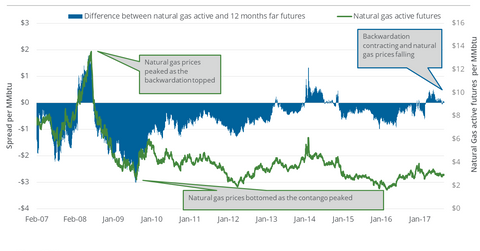Natural Gas Futures Spread: Analyzing Supply-Glut Concerns
On August 23, 2017, natural gas September 2018 futures traded at a discount of $0.03 to September 2017 futures.
Aug. 24 2017, Published 1:24 p.m. ET

Futures spread
On August 23, 2017, natural gas September 2018 futures traded at a discount of $0.03 to September 2017 futures. On August 16, 2017, the discount was at $0.02. On August 16–23, 2017, natural gas (GASX) September futures rose 1.3%.
Discount
When the discount between the two futures contracts expands, natural gas prices tend to move higher. Natural gas prices tend to be bullish when the futures spread is at a discount. For example, the discount rose to $0.5 on May 12, 2017. On the same day, natural gas prices settled at their 2017 high.
Premium
The futures spread is at a premium when contracts for delivery 12 months in the future trade at a premium to contracts for immediate delivery. When the futures spread is at a premium or the premium expands, like it did on March 3, 2016, natural gas prices tend to fall. On March 3, 2016, natural gas active futures fell to the lowest closing price in 17 years. The futures spread premium expanded to more than $0.8.
So, natural gas’s futures spread could be the key to understanding demand-supply dynamics. In the trailing week, natural gas rose and the discount expanded. It could indicate that the concerns surrounding the supply-glut situation have eased.
Energy stocks
Natural gas futures prices in the future could be vital for US natural gas producers (XOP) (DRIP) (IEO). The prices could impact their hedging decisions. The prices could also impact midstream companies’ (AMLP) (YMLP) natural gas storage and transportation businesses.
The futures spread between natural gas’s September 2017 futures contract and October 2017 futures contract could influence the United States Natural Gas Fund’s (UNG) price performance.
For more updates on upstream stocks, read Market Realist’s upstream premier.
